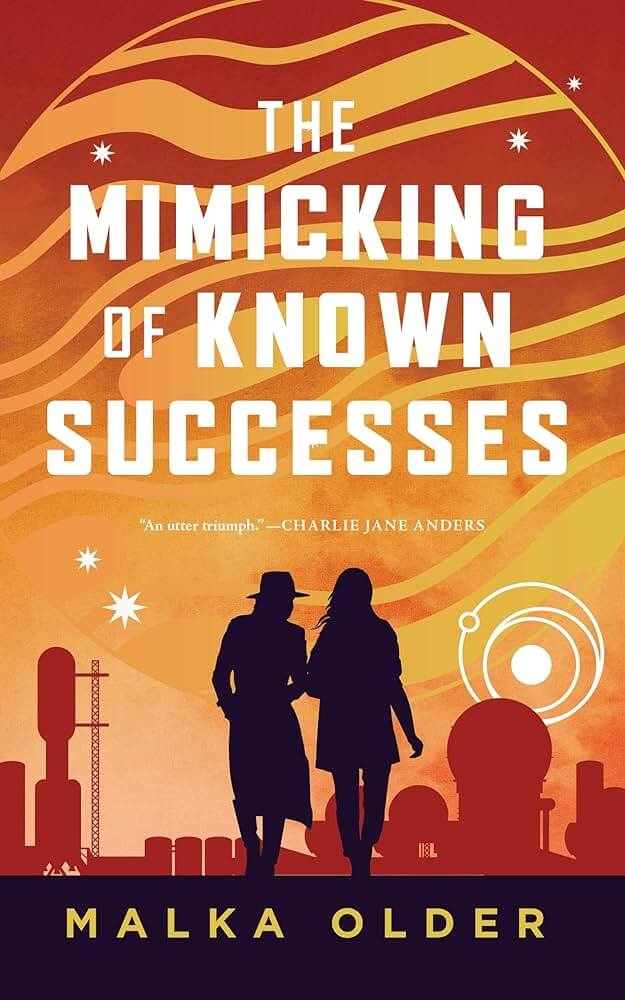…she didn’t know what had happened to the stranger either, but she found her inclination was that he hadn’t dropped off the edge of the settlement into the featureless and crushing gasses of the planet. Or at least, if he had, it hadn’t been by choice.
Humanity has been transplanted to space in Malka Older’s Hugo-nominated novella The Mimicking of Known Successes. The artificial world on Giant (formerly known as Jupiter) has been established long enough to have suburbs, universities, and famous detectives like Investigator Mossa. Mossa’s latest case involves a person who may have jumped (or been pushed) from the easternmost edge of the platform overlooking the gas giant planet below. A possible missing persons case quickly turns into a possibly-related murder case, and uncovers a plot that could change the entire course of civilization.
I got confused when picking this up and thought for a bit that this was the second in a series instead of the first; the author starts things that fast. There’s a wealth of information dropped onto the reader’s head just in the time it takes for Mossa to travel to the university town of Valdegeld, locate her former classmate (and flame) Pleiti and bring her up to speed on the investigation. We see the shape of the platforms of Giant, and the shields that keep the atmosphere inside. Words like “Classics” and “Moderns” are thrown about to show the rivalry between the factions who want to restore the destroyed ecosphere of Earth so humanity can go home, and those who want to use those resources to improve living conditions for where humanity is now. The story takes time to surround you with all the little details, like an exclusive restaurant set amongst force-grown trees, or a tavern owner sleepily talking about the (surprisingly good) stew being made with beans that were gene-sequenced years earlier in a child’s science project.

Another thing that makes this book so immersive is the age of the setting. Humanity’s escape from Earth isn’t something that happened recently, the artificial world is hundreds of years old. The characters reflect on architecture that was made “in the sinuous style of a century and a half earlier”. The age of neighborhoods can be determined from things like the building materials (smelted from nearby asteroids or constructed from old satellites and spaceships that had been flattened into sheets), or the technology used when the buildings were first constructed (Valdegeld is heated by steam, and since you can’t dig down on an artificial world you end up having to build the streets to rise over the pipes.) Humanity has long since figured out how to make shields that keep the breathable atmosphere in while also allowing in sunlight, storms, and whirling clouds of fog from the gas giant below, so people have to wrap themselves in atmoscarves as they disembark from their railcars and walk along cobbled streets through the half-light towards the warm gaslamp fires of a cozy tavern…
Oh yes, you can probably see the ambiance that the author is going for here. I’m tickled that someone has created a Sherlock Holmes-style mystery in a Victorian setting in space, and in a way that never feels forced or silly.
There’s a Sherlock/Watson type of relationship between Mossa and Pleiti as well, with a romantic backstory that also made it feel like there were previous stories already written about them. Mossa is brilliant, but also impatient and doesn’t always know how to talk to people without cutting them off mid-sentence or ordering them around. Pleiti is a brilliant scholar in her own right, and she’s useful to Mossa for her connections with other scholars and her ability to interact with other human beings. Pleiti also narrates the story in a Watson-like manner, so we see her inner thoughts as she tries to figure out her role in the story of humanity one day returning to Earth, but also tries to solve her own little mystery about her role in Mossa’s life. How does she feel about a relationship that ended years ago with so many unanswered questions? How does she feel about how she feels about that? And more importantly how does Mossa feel about her?
Believing in signs of affection from Mossa was a trap, because it led to expecting signs of affection.
The Victorian elements of hand-couriered messages and railcar time-tables aren’t just set-dressing, they’re an essential element of a mystery where the investigators have to figure out how and when someone could have left a location where it simply isn’t possible to walk across the airless void in between the rings of Giant. The author defaults to an Arthur Conan Doyle writing style that can get very intricate and entertaining, especially with Pleiti’s dry, self-deprecating commentary. The excitement picks up when Mossa and Pleiti deal with Victorian-era dangers – a suspiciously-timed animal attack, or an enemy armed with a knife – and also more space-era dangers, like a rocket that might possibly take off before the two of them can make their dramatic escape.